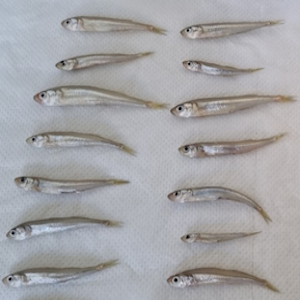Eustrongylides spp. parasite risk management in Atherina boyeri from Lake Trasimeno

Accepted: 11 July 2023
HTML: 2
All claims expressed in this article are solely those of the authors and do not necessarily represent those of their affiliated organizations, or those of the publisher, the editors and the reviewers. Any product that may be evaluated in this article or claim that may be made by its manufacturer is not guaranteed or endorsed by the publisher.
Authors
Atherina boyeri is the primary source of fishing profit in Lake Trasimeno and a common host for Eustrongylides spp. larvae. The presence of Eustrongylides in fish is a public health concern, and effective risk management procedures are necessary to guarantee that infected products do not reach the market. Currently, in the European Union, there is no official sampling plan for fresh fish that defines sample size, inspection methods, and criteria for accepting or rejecting the product. An approach to Eustrongylides risk management is proposed in this study. A total of 270 batches of A. boyeri, each consisting of 29 specimens, were collected and examined visually in 3 years (2020-2023). The prevalence of the parasite was 20% in 2020, and in the first months of 2021, it grew up to ⁓40%, then dropped to 12.50% in December 2021 and settled at 16% in February 2022. In January and February 2023, the prevalence fell below 1%. The mean abundance was calculated and used to establish a threshold value to determine fish marketability. In 2020 and 2021, several batches were judged not marketable, and in some batches, a freezing treatment was implemented to ensure the inactivation of the parasite. In the last months of 2022 and in January and February of 2023, the presence of parasites in captured fish was negligible, and this allowed the marketability of fish as fresh. The proposed sampling plan was effective in preventing the commercialization of potentially hazardous products.
How to Cite

This work is licensed under a Creative Commons Attribution-NonCommercial 4.0 International License.
PAGEPress has chosen to apply the Creative Commons Attribution NonCommercial 4.0 International License (CC BY-NC 4.0) to all manuscripts to be published.
Similar Articles
- Raffaella Branciari, David Ranucci, Dino Miraglia, Andrea Valiani, Fabrizia Veronesi, Eleonora Urbani, Giovanni Lo Vaglio, Luisa Pascucci, Raffaella Franceschini, Occurrence of parasites of the genus Eustrongylides spp. (Nematoda: Dioctophymatidae) in fish caught in Trasimeno lake, Italy , Italian Journal of Food Safety: Vol. 5 No. 4 (2016)
You may also start an advanced similarity search for this article.

 https://doi.org/10.4081/ijfs.2023.11338
https://doi.org/10.4081/ijfs.2023.11338



